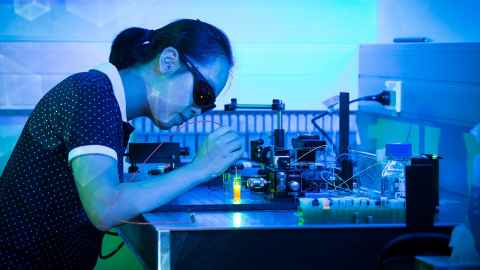Atoms, molecules and optics
We study interactions between light and matter. Our research is diverse, ranging from fundamental quantum mechanics to high-speed optical telecommunications and high-power lasers.

Research topics
Biophotonics
Biophotonics employs light to observe and understand biological systems.
We apply fluorescence spectroscopy to the study of bacteria and optical coherence tomography to eyes, cartilage, nerves and other biological tissues. We also use laser-ultrasonic imaging to study blood flow in bone and various forms of spectroscopy to assess cancerous tissue.
Bose-Einstein condensation and quantum information
At low temperatures, matter can be made to behave much like light; best described by waves. In its interactions with such matter, light can behave like it is composed of particles.
Laser cooling and trapping forms a key technique in understanding this interplay. We apply these laser cooling and trapping techniques to experimental research areas of fundamental atomic physics, quantum chaos, quantum information, and atom lasers. From this research emerges a deeper understanding of the quantum world, which determines in turn what happens in the world around us.
Laser physics
We design and use lasers for applications ranging from laser cutting and material processing to high-resolution spectroscopy and nonlinear microscopy.
Much of our design efforts are devoted to building lasers out of optical fibres. By replacing a section of an optical fibre cavity with an active optical fibre doped with rare-earth elements, such as Erbium or Ytterbium, we can convert a resonator into a laser. By inserting an element that promotes the formation of high peak power pulses inside the cavity the laser can be made to deliver trains of ultrashort pulses.
Such mode-locked fibre lasers possess numerous benefits compared to their solid-state counterparts such as compactness, low-manufacturing cost and lack of sensitivity against misalignment.
Optical microresonators
An optical microresonator consists of a glass or crystalline waveguide looped on itself to form a tiny ring. The ultra-high quality of these microresonators allows them to trap and store light for extremely long periods.
We use optical microresonators made from materials such as silicon, lithium niobate and magnesium fluoride to perform high sensitivity spectroscopic measurements and build new types of optical source. For example, microresonators possessing a Kerr nonlinearity offer the unique prospect of generating optical frequency combs in miniaturised, low-power, and even integrated on-chip, platforms.
Demonstrated applications of these ‘micro-combs’ range from sensing and coherent telecommunications, to ultra-fast ranging systems capable of tracking a single bullet in flight.
Nonlinear optics
We investigate the fundamental nonlinear processes that can occur when light of sufficiently high intensity interacts with matter.
Nonlinear optics have enabled the Nobel Prize-winning technologies of optical frequency combs and super-resolution microscopy. They also allow for the development of optical oscilloscopes with a sub-picosecond resolution and all-optical memories; suitable for high-speed telecommunications and future optical computers.
Quantum optics
Quantum optics studies the quantum mechanical features of optical and related (e.g. microwaves) phenomena. Such features depend on photons and their quantum states. Current research focuses on quantum-based schemes for processing information (quantum cryptography, computing, metrology and simulation).
Our work focuses on a range of specialised topics within this field, all linked by the underlying theme of open quantum systems.
Terahertz (THz) spectroscopy
As a recent development, coherent THz spectroscopy fills one of the last gaps in the electromagnetic spectrum. In contrast to the optical region, there has been very little research in the THz range.
We study whispering gallery modes (WGMs) in Silicon microresonators and have achieved record-breaking quality (Q) factors. We employ Si discs as resonators, which are much thinner than the vacuum wavelength of the THz radiation. Therefore the WGMs have a large evanescent field ideally suited for sensing.
Related research organisations
Our researchers
Dr Claude Aguergaray
- Fibre lasers
- Nonlinear fibre optics
- Biophotonics and optical sensing
- Laser micromachining and microfabrication
Professor Neil Broderick
- Nonlinear dynamics of optical systems
- Fibre lasers
- Optical sensing
- Laser micromachining and microfabrication
Associate Professor Stephane Coen
- Nonlinear fibre optics
- Optical microresonators
- Kerr frequency combs
Dr Miro Erkintalo
- Nonlinear dynamics of optical systems
- Optical frequency combs
- Optical microresonators
- Fibre optics
Dr Maarten Hoogerland
- Ultra-cold atoms
- Bose-Einstein condensation
- Atom optics
Dr Cushla McGoverin
- Vibrational spectroscopy
- Fluorescence spectroscopy
- Biophotonics
- Chemometrics
Associate Professor Stuart Murdoch
- Fibre optics
- Optical microresonators
- Kerr frequency combs
- Optical parametric devices
Associate Professor Scott Parkins
- Theoretical quantum optics
- Cavity quantum electrodynamics (cavity QED)
- Many-body cavity QED and interacting spin systems
- Nonclassical states of light and atoms
Professor Cather Simpson
- Ultrafast spectroscopy
- Quantum chemistry
- Laser micromachining and microfabrication
Associate Professor Frederique Vanholsbeeck
- Biophotonics
- Optical coherence tomography
- Optical sensors